Hi, everyone. "Moriarty" here with some Rumblings From The Lab...
Holy crap. I just did a quick search through the release schedule for the rest of the year, and so far, as of the start of July, I already see 190 more titles that I know I’m going to buy before December ends. That’s not including the stuff that hasn’t been announced yet and the R2 and R3 stuff like 800 BALAS and OLD BOY and ONG BAK that I’m still trying to track down. That’s another bookcase I’m going to have to add to the front room, just as I finally get that room all organized and pretty. Damn this vile addiction...
Well, I say that, and then I go and swim around in my movies, Scrooge McDuck-style, and cackle with unabated glee, so call me complicated, I s’pose. Anyway... let’s get to it.
And, yes, I know. Been a while, hasn’t it? There’s been so much cool stuff happening lately that I’ve had to pick and choose what I can write about, and the result is that my absolute favorite thing to write about has fallen by the wayside, something that drives me crazy. I love this DVD column. I love writing about this format and discussing all this stuff with you guys. But when the opportunity comes up to review THE LIFE AQUATIC or SKY CAPTAIN or go to premieres for THE TERMINAL and ANCHORMAN... well... it’s hard to say no.
This month, I want to make that up, though, or at least get started. I want to try to pound out as many of these columns as possible and make a serious dent in the stack of stuff I’ve got set on my desk that’s been watched and is ready for review. Before I do, I have a little housekeeping to take care of. One of the entries in the FREAKS & GEEKS contest turned out to be a fake. When I asked the guy to send me a current photo of himself to prove that he was the person in the picture, he insulted me and never wrote back. Figures. To those of you who seemed surprised that I hadn’t seen the photo on other sites, I really don’t spend time on Rotten.com or Uglypeople.com, and wouldn’t recognize material that’s been run there.
As a result, I’ve re-awarded the prize to the first runner-up, and I’m even going to be nice enough not to run his picture and embarrass him. All of you who won the F&G prizes should see them in the mail early next week. As far as the SCTV contest is concerned, I’m sorry, but it appears that the company that offered up the prize packages decided not to send them out for one reason or another, so I can’t hand out those prizes. In the future, I’m going to wait until the prizes are here at the Labs before I run any contests, just to avoid this sort of thing. You guys did a great job with the entries, and I appreciate the effort. I am sorry not to be able to make good on the contest, and will try to figure out a way to make it up to you soon.
I’ve recently gotten my entire DVD collection set up at DVD Aficionado, a great site that I’ve enjoyed working with. Yes, I know there are other database sites out there, but I like the way this one’s laid out, and with very few exceptions, I’ve been able to find all my titles in their archives. You can check it out right here if you’re curious, and I’ve made sure to point out what was purchased, what was sent as a screener, and what was a gift, since so many of your e-mails seemed to think that was so urgently important.
(Click header to go directly to the section)
MURDER, MY SWEET and GUN CRAZY
Criterion’s THE TIN DRUM
UPTOWN SATURDAY NIGHT and LET’S DO IT AGAIN and A PIECE OF THE ACTION
THE SUNSHINE BOYS and GOING IN STYLE
SPARTAN
SECRET WINDOW
JAPANESE STORY
THE STATION AGENT
BLAZING SADDLES: 30th Anniversary Edition
SCTV NETWORK 90: Volume 1
MURDER MY SWEET
GUN CRAZY
I love film noir. It’s one of those genres where even the lesser entries are normally worthwhile in some way. I think I just dig the aesthetic. When Warner Bros. sent over all five of the releases that are part of today’s box set for review, I couldn’t have been any happier. My all-time favorite film in the genre is one of them, but I’ll save my review of that for next time. Today, I’ll just discuss the first two I popped in.
MURDER MY SWEET is, very simply, noir the way it is supposed to be done. We start at the end, with Philip Marlowe’s eyes bandaged, sitting under the hot light of an interrogation room. The police grill him about what happened, and then we flash back with him, all the way back to the night when a big lug named Moose hired Marlowe to find his girl. Two-bit barkeeps, sinister back-alley doctors, sloppy drunk floozies who aren’t really drunk, wiseguy elevator operators, flatfoot cops with chips on their shoulders... they’re all part of the world that director Edward Dmytryk plunges you into.
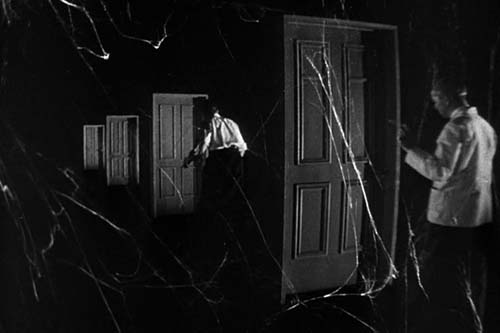
John Paxton’s done a good job adapting Chandler’s FAREWELL, MY LOVELY, and he’s managed to preserve a lot of the language that makes Chandler’s writing so eternally interesting, as in a scene where Marlowe takes a shot to the back of the head:
”I caught the blackjack right behind the ear. A dark pool opened up at my feet. I dived in. It had no bottom.”
Subplots are introduced that seem to have nothing to do with the main story, but of course, it’s all part of the same web of deceit that Marlowe’s caught in. Blackmail, murder, and robbery are just the surface of what’s going on, and no matter how snappy Marlowe’s comebacks are, he keeps getting in deeper. At one point, he ends up drugged and locked up, and the greatest challenge he faces is just putting his pants on. It’s got a great jet-black sense of humor, but it’s never a comedy. Instead, it walks that fine line in a way that many modern filmmakers seem incapable of accomplishing.
I’d bet money that this is one of the films that the Coen Bros. watched while putting together THE BIG LEBOWSKI. There are some bold visual flourishes here courtesy of cinematographer Harry Wild that make the film an internal trip, all from Marlowe’s point of view. Anyone who loves the slang of the old noir films will have a blast listening to this one, and Dick Powell does a damn fine job of leaving behind his image as a song-and-dance man with his down-at-the-heels Marlowe. The disc manages to beautifully reproduce the picture, and it’s well worth picking up, especially if you’ve never had a chance to succumb to its charms before.
Another of the noir titles that Warner is releasing this week, this starts out white-hot and ends up as an effective study of just how subversive material could sometimes sneak past the censors in the uptight late ‘40’s. John Dall’s the lead here, but Russ Tamblyn plays him as a child at the start of the film. He’s absolutely smitten with guns, consumed by the thought of them. When he breaks into a pawn shop to steal one, he gets popped by the cops. At his trial, his friends explain that ever since he killed a bird, he’s been completely harmless, and that he can’t shoot any living thing, but the judge is unmoved, and he’s sent away to a reformatory. Dall makes his entrance as Bart when he comes back to his home town, fresh from a stay in the Army. He’s determined to live a normal life, only occasionally enjoying guns as a recreational thing.
But there’s this dame, see. There’s always a dame in these movies, and in this case, it’s Annie Starr, who he meets at a carnival where she works as a sharpshooter. He gets called up onstage as part of a challenge, and just watching the two of them size each other up as they fire at targets is one of the most carnal and blatantly sexual scenes I’ve seen in a movie this year, old or new. If David Cronenberg made this movie, it would be the CRASH of gun fetishists, a film that NRA members could beat off while watching. To the credit of director Joseph H. Lewis, it comes pretty close. Peggy Cummins plays Starr, and she’s a feral little thing, all of Bart’s worst instincts wrapped up in a hot piece of ass, driving him further and further astray.
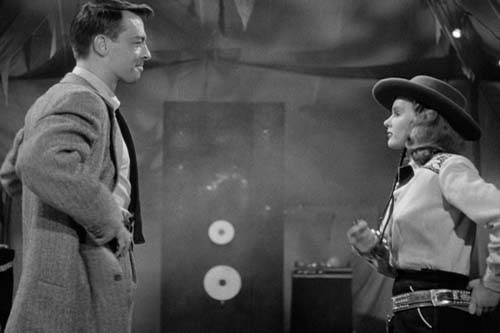
What makes this a classic of the genre is the way it perfectly fits the formula of film noir without feeling calculated. As with the best noir stories, there’s a horrible inevitability to what unfolds. Once these two losers hook up, there’s nowhere to go but down. Both of the leads do great work, and the supporting cast is filled with familiar faces, even if you can’t necessarily name them.
As with MURDER MY SWEET, there’s a commentary track featuring a noir historian. In this case, it’s Glenn Erickson, and he does a hell of a job making his case for why this picture deserves its spot in the National Registry as well as a permanent home on your shelf.
Criterion’s THE TIN DRUM
Obscene? Possibly. Surreal? Emphatically. An important work of film art? Without question.
Any number of directors (including Roman Polanski, who allegedly offered to also play the lead role) tried to get the rights to adapt DIE BLECHTROMMEL, the blistering novel by German author Gunter Grass, but it was Volker Schlondorff who finally pitched the version that got the author to agree. The result is a film that feels just as fresh and original now as it must have when it went off like a hand grenade at the Cannes Festival in 1979, where it won the Palme D’or.
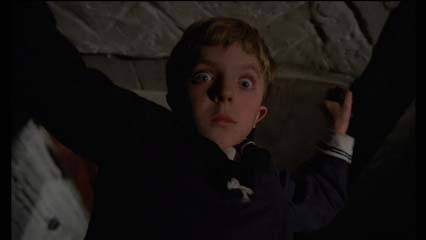
Oskar Matzerath is born in Danzig in 1924, and even as a fetus in utero, he seems hyperaware of his surroundings. More than that, he is repulsed, angered, and horrified by the world he’s born into. Little wonder. Schlondorff is a bitter social satirist with a keen eye for the most jet-black of punchlines. He and his director of photography Igor Luther create a grotesque cartoon version of Poland and Germany in the years leading up to World War II, and it really does feel like we experience it all through the wide, otherworldly eyes of Oskar.
He’s one of the strangest characters I’ve ever seen on film, and part of that stems from the miraculous casting of David Bennent as Oskar. He’s like an alien, a special effect. Only 12 years old when he starred in the film, he plays Oskar from infant to adult, giving a performance that ranks among the very best in film history in any language. Oskar simply decides to stop growing at the age of three. Not one inch more, he decides. He utterly rejects the adult world, choosing to stay a child, expressing his anti-social rage not only through the red-and-white tin drum that he carries everywhere, but also through a glass-shattering scream that he learns to control to devastating effect.
One of the best things about the Criterion Collection, ever since they started back in the dinosaur days of laserdisc, is the way their best sets place a film in context, discussing the production, the release, and even the cultural impact. Not only is this a spectacular transfer, it’s also got a full-length commentary by Schlondorff, an isolated track for the score by Maurice Jarre, a new subtitle translation, and a remastered Dolby Digital 5.1 soundtrack. And that’s just on the first disc. The second disc has deleted scenes, a beautifully constructed piece called “Volker Schlondorff Remembers” featuring photos, storyboards, and all sorts of personal odds and ends. There’s a fistful of interviews, including one with Bennent at the ’79 Cannes fest that is a must-see for any fan of the film. There’s a live appearance by Gunter Grass reading From the novel in 1987, along with an improvisational percussionist, a unique experience to say the least.
And then there’s the short documentary, “Banned In Oklahoma,” which details the now-notorious incidents in which the film was ruled obscene by local law enforcement and pulled off shelves. It’s fairly unbelievable stuff, a textbook case of how one small-minded special interest group manages to impose their will on an entire community. I wish this were an isolated, freakish incident, but I’ve lived all over the United States, and I’ve seen this sort of behavior time and time again. What constantly reaffirms my faith in America is the way these anti-intellectual bigots usually get slapped down by the courts, and art manages to triumph. There is an extra level of irony to an obscenity battle being fought over this particular film, and anyone who watched it with an open mind would have been instantly struck by the absurdity of it all. If you’ve never seen the movie, you owe it to yourself to check it out, and if you’re already a fan, this is a celebration of this controversial classic, and a real gem in the Criterion library.
In 1974, 1975, and 1977, Bill Cosby and Sidney Poitier teamed up for three comedies. While they’re not sequels in the strictest sense of the word, they certainly form a trilogy of sorts, and I was thrilled that Warner Bros. finally put the movies out on DVD earlier this year. Having finally seen them all again, I still love two out of the three movies, and I’m fascinated with them as a particular slice of pop culture.
UPTOWN SATURDAY NIGHT is clearly the best of the three films, and it’s the script by Richard Wesley, who also wrote LET’S DO IT AGAIN, that gives Cosby and Poitier plenty of room to play. There’s something very sweet and conservative about Poitier as a director that becomes cloying with a weaker screenplay, as with Charles Blackwell’s pedestrian work on A PIECE OF THE ACTION. On UPTOWN, though, Poitier strikes just the right balance, and he seems to have enormous fun with his sizeable supporting cast featuring actors like Harry Belafonte, Roscoe Lee Browne, Flip Wilson, and Richard Pryor as the hilariously shady private dick, Sharp Eye Washington. It’s a caper film, pure and simple, and when they returned a year later for LET’S DO IT AGAIN, they stuck pretty close to what made the first film work. This time, Cosby and Poitier are given support by Ossie Davis, Julius Harris, John Amos, and the one and only Jimmie Walker in an absurd but funny story about boxing and hypnosis and church fundraising by any means necessary.
What rubbed me the wrong way about A PIECE OF THE ACTION is the way it suddenly wants to add in a social drama a la TO SIRT WITH LOVE, sapping the caper elements of all the fun of the first two films. Also, Cosby and Poitier aren’t playing friends in this one, which is no fun at all. It’s just a bummer, considering how great the first two films are.
Of course, it could be worse. It could be GHOST DAD.
Warner Bros. has put different extras on each of the three films. UPTOWN’s got a great commentary by Dr. Todd Boyd, a USC professor of cinema and television, a guy who I’d definitely love to sit down and talk to sometime. He also shows up in the documentary retrospective on the disc, along with a number of other people, all of whom set the cultural context to best appreciate the movie. On LET’S DO IT AGAIN, there’s a commentary by the screenwriter and NEW YORK PRESS film critic Armond White, and on A PIECE OF THE ACTION, there’s another documentary featuring most of the same faces from the first disc. The transfers on all three films are about as good as they’re going to be, the Curtis Mayfield scores sound great, and anyone who loves these movies can’t go wrong for the price. If only they weren’t in those crappy cardboard snapper cases...
... which is the same complaint I have about these two George Burns films. They’re just so flimsy, and for anyone who actually wants to keep these films as part of a library, it’s frustrating.
Still, I am glad that Warner Bros. spends so much time releasing catalog titles every year. They’ve got so many movies in their vaults that no matter how quickly they put these movies on the market, they’ll never totally clear their shelves. I’ve personally been waiting for Martin Brest’s film for years, and was delighted to finally be able to buy it.
Warner was smart to put SUNSHINE BOYS out on the same day, because I didn’t think twice about picking it up to go with GOING IN STYLE. I should have, though. Growing up, I read a lot of Neil Simon. He was the most successful playwright of the ‘70s, and as a kid, I assumed that meant he was one of the best working playwrights. Looking at the majority of his work now, it strikes me as glib, easy setups and punchlines, clever without any real insight or weight. There’s something about the sitcom quality of the writing that doesn’t sit well with me, and the flat direction of Herbert Ross doesn’t elevate the material one bit.
What good there is about THE SUNSHINE BOYS comes from the performances by Walter Matthau and George Burns as two former vaudevillians who are brought back together for one last performance as a team. Both men were Oscar nominated, and Burns actually won, which isn’t surprising when you see how he manages to undersell even the most obvious of Simon’s lines here. They do a wonderful job of suggesting an entire lifetime of acrimony with every conversation, and you are dealing with two undisputed masters of comic timing. They can spin gold with pretty much anything they’re given to say.
The disc offers a glimpse at what might have been if the casting hadn’t worked out. Matthau was playing much older than his actual age at the time, and several actors read to play opposite him, many of whom were actually in their 70s. The disc features a make-up test with Matthau and Jack Benny together, and a separate screen test for Phil Silvers. There’s also a feature-length commentary by Richard Benjamin, who plays Matthau’s son in the film, but I haven’t listened to it, and I’m not sure I’m in any rush to revisit the movie.
On the other hand, I’m so happy that I can finally enjoy GOING IN STYLE whenever I want. Martin Brest may be in director’s jail right now because of GIGLI, but when you look back at where his career began, it’s a nice reminder of just what this writer/director can do. George Burns, Lee Strasberg, and Art Carney play three friends who share an apartment, trying to scrape by on their combined Social Security checks. Burns comes up with the idea to rob a ban so they can retire well, noting that if they get caught, their checks will stack up while they’re in jail and earn enough interest that they’ll still end up sitting pretty. Either way, they win.
This is a movie of gentle pleasures, and watching these three actors together is as good as it gets. Part of what makes it so special is the mix of three totally different acting styles. Strasberg is one of the creators of method acting, Burns is a vaudeville-trained comedian, and Carney... well, Carney doesn’t seem to have any particular training at all. He’s just a force of nature, natural and hilarious, which is what makes him so compelling. They have spectacular chemistry with each other, and Brest’s script is sweet-natured and smart without ever becoming cloying or overly sentimental. The only real extra on the disc is an appearance on Dinah Shore’s talk show by Carney and Burns, and it’s certainly funny, but hardly the reason to buy the disc. This is one of those cases where the movie is more than enough.
I’m of mixed opinion about David Mamet as a filmmaker. He’s written some of my favorite scripts ever, like THE UNTOUCHABLES and (especially) THE VERDICT, and I’ve enjoyed some of the movies he’s written and directed, like HOUSE OF GAMES and HOMICIDE and STATE AND MAIN. I don’t think he’s always brilliant, though, and one of my favorite films from his work is GLENGARRY GLEN ROSS, which is great in no small part because of the direction by James Foley. Mamet seems to sap the dramatic tension from his own writing sometimes, and it can be frustrating to watch.
SPARTAN has its moments. Val Kilmer does some strong work as an agent in an unnamed shadowy branch of the government, sucked into a world of deceptions and double-crosses when the daughter of a high-level politician goes missing. If that sounds a little vague, it’s because Mamet’s script plays it coy. He refuses to put names on things, instead putting the emphasis on the general terror of a situation. Of course, in typical Mamet fashion, everything’s played at a remove, so detached that it’s hard to relate to anyone as a character. They’re types, and even worse, they all sound exactly the same, exactly like most of the characters in films Mamet directs... mannered, artificial.
Which isn’t to say I hated it. The chemistry between Kilmer and Derek Luke is strong, and I liked the way the story twisted in on itself at times. The real highlight of the DVD, though, is the audio commentary by Kilmer. I know he’s got a reputation for being an asshole in the industry, but I think he’s just unrelentingly honest about his opinion, like a stroke patient who lost the ability to set any social filters on what he says. It’s fascinating, especially because Kilmer seems unimpressed by the legend of Mamet. For the commentary alone, I’d say this is worth at least a rental for any fan of the director’s as a more revealing look inside his process than he may have intended.
Eh.
I think David Koepp’s a smart guy, the sort of writer who gets it on an intellectual level, but I rarely find myself moved by the work he does. This hybrid of MISERY and THE DARK HALF wasn’t one of Stephen King’s strongest works to begin with, and the adaptation hasn’t done it any favors. It’s tastefully made, well-acted, aimed at adults (which is always a pleasant surprise from a studio-made horror film), and in the end, pretty aggressively boring.
Part of the problem is that watching someone write is inherently uncinematic. It’s an internal process, and no matter how you try to punch it up, it’s not terribly interesting, and leaves the audience standing outside. What complicates things is the fact that the entire story is built around a “shocking twist” that isn’t particularly shocking if you’ve been to a movie theater in... oh... let’s say that last decade or so.
What works about the film basically boils down to Johnny Depp. He seems to have hit his stride recently, and even for longtime fans of his work, it’s obvious that he’s turned a corner as a performer now. He’s got a new confidence about him, an effortlessly crowd-pleasing capability that’s crept into his work. John Turturro is pretty good as the source of all of Depp’s sorrows, and the moments they share are pretty undeniably entertaining. I even admire just where Koepp chooses to end this one, since he sticks to his guns and never backs off from the dark tone of the work. It’s impossible to get past the feeling that we’ve seen it all before, though, at least for me. If you were a fan of it, the disc appears to be loaded with extras like deleted scenes and a commentary and behind-the-scenes featurettes, but I can’t personally work up the interest to delve any deeper into this particular GARDEN.
Beautiful and strange and nearly impossible to predict, this ethereal story by screenwriter Alison Tilson and director Sue Brooks gives Toni Collette one of her best roles to date, and delivers a surprising emotional punch. She plays Sandy Edwards, a partner in a company that sells software to geological companies. When a potential client comes in from Japan, Sandy gets stuck driving him around the most remote corners of Australia. When she meets Hiromitsu (Gotaro Tsunashima), she’s deeply unimpressed, and the more she’s stuck with him, the less she likes him.
Saying anymore about the way the story unfolds would be unfair. It’s actually quite magical the way it manages to keep you off-balance emotionally. Both Collette and Tsunashima do wonderful work, laying themselves bare. What makes it so hypnotic is the terrific widescreen cinematography by Ian Baker. He brings Australia to vivid life, and gives the actors an epic landscape against which they play out this powerfully intimate story. This is definitely a tiny gem, well worth seeking out, and the DVD does a wonderful job of reproducing both sound and picture.
Sometimes, hearing that a film was a big hit at Sundance actually turns me off to seeing it. I’ve been to Sundance. I’ve seen the way audiences let the thin high-altitude air affect their judgment, especially when it comes to “feel good” movies. As a result, I skipped THE STATION AGENT in theaters, and it turns out the joke is on me. This is exactly as good as you’ve heard, warm and human and utterly unique.
Writer/director Tom McCarthy manages to avoid all the clichés that can derail this sort of quirky character study. He refuses to give in to cheap sentimentalism, instead telling an emotionally honest story about three people looking for some sort of connection to the world, even as they struggle with their individual fears and hurts and withdraw from everyone around them. Peter Dinklage is charismatic and commanding as Fin McBride, a dwarf living a quite, private life working in a model train store. He’s insulated himself from the world, only occasionally having to deal with the casual cruelty of strangers, but all that changes when the shop’s owner dies.
Fin inherits a long-closed train depot in a town in the middle of nowhere, and looks at it as an opportunity to retreat even further. Unfortunately, a force of nature named Joe comes into his life, embodied by Bobby Cannavale in one of the most joyous performances I’ve seen in a while. Joe’s running a small food wagon for his ailing father, and he’s going a little crazy from having no one to talk to. Add a mysteriously heartbroken local woman, Olivia, played by the always-wonderful Patricia Clarkson, and the rest of the film is simply about the way these people bounce off one another, and the changes they bring to each other’s lives. It really is just that simple. This is a movie that’s all about chemistry, and every member of the cast does a beautiful job.
If you want an idea of how this sort of alchemy occurs, the audio commentary on the disc does a wonderful job of showing how the cast came together with the filmmaker to bring the story to life. It’s specifically actor-oriented, and the enormous respect that McCarthy has for his cast is obvious. This is the kind of film that you don’t really want to oversell, and it’s a gentle charmer for sure, but if you want to spend an evening with a feel-good movie you can still respect the next morning, this is a sure bet.
The night the second Rodney King trial came to a close in Los Angeles, it felt like the entire city was holding its breath. You had to live here during the riots to understand just how tense things were, and that chaos was still fresh in the minds of most of us. Thanks to a fluke of timing, my friends and I had tickets to see the 20th Anniversary re-issue of BLAZING SADDLES in Westwood that night, and we strongly debated whether or not we should go. We’d bought our tickets weeks earlier, and in the end, we decided that we might not get another chance to see the film on the bigscreen, so we headed over to the Mann’s Village to take our chances. The theater was packed, too. I’d guess that about half the audience was white, and half the audience was black, and as we were in the lobby, we heard some of the theater staff talking about what to do if things got out of hand.
They shouldn’t have been worried. By about ten minutes in, the entire theater was laughing uproariously, and as the city outside wrestled to figure out what to make of the fresh verdict, everyone in that theater left all that baggage at the door and just laughed, united by the scathingly filthy classic that Mel Brooks and his lunatic collaborators made, a testament to how brilliant that film really is. Even now, a decade later, it still feels incredibly edgy and modern.
Warner Bros. has done a nice job of paying tribute to this landmark comedy, and every fan of the film should pick up a copy immediately. First and foremost, the anamorphic widescreen transfer is stunningly beautiful, easily the best transfer of it that’s ever been done for home video. It looks brand-new, vivid and rich, and it sounds great, too. What makes the disc such a joy for fans is the “Back In The Saddle” documentary that looks back at the making of the movie as well as the feature-length commentary by Brooks. Any trivia you’d ever want to know about the film is well-covered here, and even though the commentary isn’t really related to anything happening onscreen at any given moment, it’s entertaining and feels like you’re just spending a few hours sitting and chatting with Brooks.
I’ve got to say, I was also delighted to finally see BLACK BART, the TV pilot for a proposed spin-off series. I’ve read about it over the years, but it’s never been available until now. It’s surprising how close it is to the film in terms of tone and language, but it just doesn’t pack the same punch. Lou Gossett Jr. does his best as Bart, but Andrew Bergman isn’t able to reach the same manic heights of hilarity on his own that Brooks was when working with his incredible cast and his wonderful herd of co-writers, including Richard Pryor, whose main contributions evidently focused on the character of Mongo, who Pryor fell in love with during the process. “Mongo just pawn in game of life” is one of Pryor’s lines. Who knew?
Just watching this disc to prepare this review, I’ve fallin in love with this movie all over again. Cleavon Little, Gene Wilder, Slim Pickens, Burton Gilliam, Madeline Kahn, Harvey Korman, David Huddleston, John Hillerman, Alex Karras, Dom DeLuise... they’re all great here, giving classic comic performances. The picture itself is just timeless, always funny no matter how often I return to it, and this is a DVD that any student of great film comedy is absolutely required to add to their film library.
Right now, Shout! Factory is putting together some of the very best DVD box sets of television shows on the market. Their FREAKS & GEEKS box was exceptional, dense with extra features that illuminated elements of the show for even the most ardent fans. Now they’ve hit another home run with a long-time dream for fans of the cult comedy series SCTV. When the show aired on NBC starting in May of ’81, the episodes were each 90 minutes long, but they’ve been butchered in syndication over the years. Music rights and running time were a few of the issues, and it’s been frustrating for anyone who remembers what a wonderful antidote the series was to SATURDAY NIGHT LIVE, which was going through one of its worst creative droughts at that particular moment. By the time it hit NBC, there were already several seasons of SCTV material that had been created, starting in 1976 for Global Television in Toronto. For five years, the show was produced in half-hour form with various cast members rotating in and out.
Personally, I never saw the show until it hit the American airwaves, and it seemed fully formed to me right away, rich with character, immediately pulling me in. The parodies on the show were specific, wicked, and multi-layered (who else could do both Russian playwrights and STAR TREK at the same time?), but it was the oddball collection of original characters that won me over. Guy Caballero, the skinflint station manager who only used his wheelchair “for respect.” Edith Prickley, the disturbingly horny station manager who managed to work leopard-print into everything she wore. Johnny LaRue, the perpetually overbudget and crane-obssessed producer/actor. Bob and Doug McKenzie, the amiable goofball hosts of THE GREAT WHITE NORTH. Dr. Tongue. Count Floyd. Mrs. Falbo. Big Jim McBob and Billy Sol Hurok. Bill Needle. Earl Camembert. Mel Slirrup. Tex and Edna Boil. And dozens and dozens more, all of them loaded with quirks and sharply performed by the core cast of Eugene Levy, Joe Flaherty, Dave Thomas, Rick Moranis, Andrea Martin, Catherine O’Hara, and the late great John Candy.
What I love most about these shows is something SNL never managed, a sense that all of this inspired madness was taking place in the same world, at the same time. There are running jokes that not only weave through entire episodes, but through the entire series. Being able to see these episodes uncut, in their original order, I’m even more impressed by the series. Time has been very kind to the show, a testament to the high quality of the writing. Even better, Shout! Factory has put some great extras on the discs, including a reunion at the U.S. Comedy Arts Festival in Aspen, a moving tribute to Candy, a featurette about the development of the series, another that allows the cast to share their favorite memories and to bust each others’ balls mercilessly, and some commentaries by Levy and Flaherty that are absolutely hilarious. At five discs, it’s amazing that this set only covers the first nine episodes. There’s a wealth of material still to come, and I can’t wait to see the future sets as they are released.
UPTOWN SATURDAY NIGHT
LET’S DO IT AGAIN
A PIECE OF THE ACTION
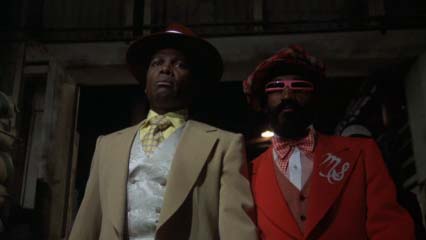
THE SUNSHINE BOYS
GOING IN STYLE
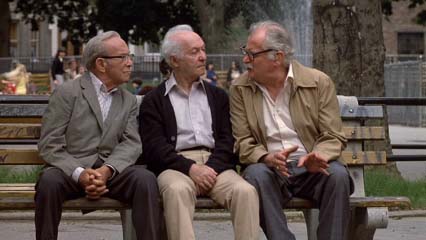
SPARTAN
SECRET WINDOW
JAPANESE STORY

THE STATION AGENT
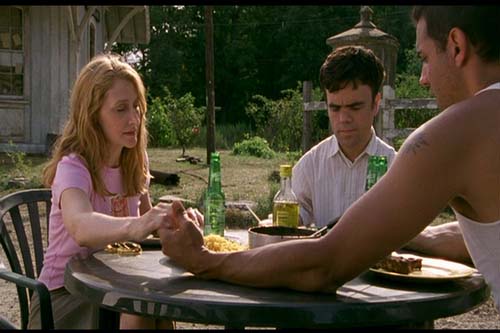
BLAZING SADDLES: 30th Anniversary Special Edition
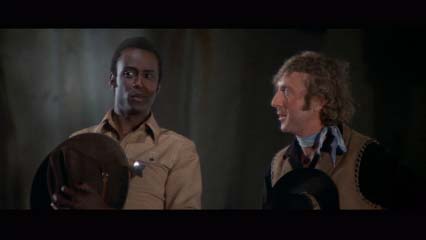
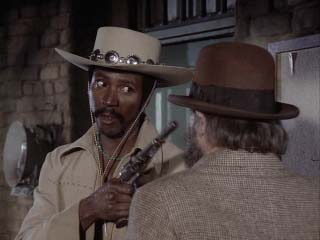
SCTV NETWORK 90 Volume 1
That’s it for this time. Like I said, I’m going to try to do this more regularly. I have about 70 titles backed up that I want to write about, so if I can do smaller columns, and more of them, I may make a dent in this stack and be able to share more of this material with you. Next time, I’m going to look at all the recent TARZAN releases by Warner Bros, the amazing new BATMAN animated collection, more of those wonderful new noir titles, a remarkable little oddity called HOW’S YOUR NEWS?, some truly classic titles like IKIRU and PATHER PANCHALI, and much more.
In the meantime, watch the main page for some great interviews with Will Ferrell, Adam McKay, and the directors of METALLICA: SOME KIND OF MONSTER to round out this week. Gotta get busy on those transcriptions right now, so I’ll just say...
"Moriarty" out.

